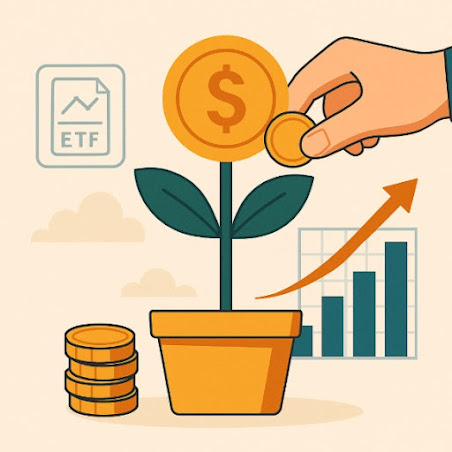1.
What
Is Investing?
Investing is when
you put your money into something with the goal of making more money over time.
It’s different from saving. When you save, your money stays safe but grows very
slowly (if at all). When you invest, your money has the chance to grow more—but
there is also a risk you could lose some or all of it.
Imagine planting
a seed. If you water it and take care of it, it may grow into a tree that gives
fruit. That’s the basic idea of investing.
People invest for different reasons. Some
want to save for retirement, others for a house, a child’s education, or simply
for more financial freedom in the future. Investing can help your money grow
faster than just keeping it in a savings account.
Let’s meet
Peter. He started putting aside just £50 a month into a simple investment plan.
After a few years, he noticed that not only had he saved money—his investments
had grown too. He didn’t have to be rich to get started.
2.
What
Can You Invest In?
There are many
different things you can invest in. Here are the main types:
·
Stocks (or Shares): When you buy a stock, you own a small part of a
company. If the company does well, your stock becomes more valuable.
·
Bonds:
You lend money to a company or government, and they pay you back with interest
over time.
·
Mutual Funds and ETFs: These are collections of stocks or bonds. They are
managed by professionals and offer a simple way to invest in many things at
once.
·
Real Estate: Buying property to rent or sell later.
·
Commodities: Things like gold, oil, or crops.
For most new
investors, starting with mutual funds or ETFs is the easiest and safest way to
begin.
What Does “Diversifying” Mean?
You might hear people talk about “diversifying your
portfolio.” That just means not putting all your eggs in one basket.
If you invest
all your money in one company and it fails, you lose everything. But if you
spread your money across many companies, industries, or types of investments,
your risk is lower. Some investments might go down, but others might go up—and
that balance can protect you.
Even with a
small amount of money, you can diversify. How? By using ETFs (Exchange-Traded Funds) or robo-advisors (apps or websites that
manage your investments automatically). They let you buy a tiny piece of many
different investments with one simple purchase.
3.
How
Much Money Do I Need to Start?
You don’t need
to be wealthy. Many apps and online platforms let you start with as little as
£10 or $10. You can even set up a plan to invest a small amount each month.
Over time, small amounts can grow into something big.
Investing always involves risk. That means
there’s a chance your investment could go down in value. But with more risk
often comes the chance for more reward (profit).
For
example:
·
A savings account
is low risk and gives low rewards.
·
Stocks are higher
risk but can give higher rewards over time.
The key is to
find a balance that you’re comfortable with. If you’re new, it’s okay to start
small and choose safer options while you learn.
4.
The
Magic of Time and Compound Growth
One of the best
things about investing is compound growth.
This means you earn money not just on your original investment, but also on the
profits you’ve already made.
Think of it
like a snowball rolling down a hill—it gets bigger and bigger as it goes.
The earlier you
start, the more time your money has to grow. Even if you start small, time can
work in your favor.
How to Get Started in 5 Simple Steps
5.
How
Can I Diversify My Portfolio with a Small Investment?
Great question!
If you only have a little money, you might think you can’t invest in many
different things. But thanks to technology, you can.
Here’s how:
·
ETFs:
These let you buy small parts of many companies at once. One ETF can include
hundreds of stocks.
·
Fractional Shares: Some platforms let you buy just a piece of a stock
instead of a whole one. For example, instead of buying a whole Amazon share
(which can be expensive), you can buy just £5 worth.
·
Robo-Advisors: These are smart tools that automatically invest your money across many
assets, even if you’re starting with just a few pounds.
With any of
these options, even a small investment can be spread across a wide range of
companies and industries. That’s diversification!
Final Thoughts
Investing doesn’t have to be scary or complicated. You don’t need a lot of money, and you don’t need to be an expert. Just like Peter, you can take small steps and learn as you go. The key is to get started, stay consistent, and give your money time to grow.
🧠 Questions
& Answers
Start small. Learn as you go. And remember: the best time to invest is when you're ready. Even a little today can become a lot tomorrow.







No comments:
Post a Comment